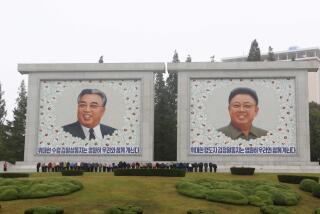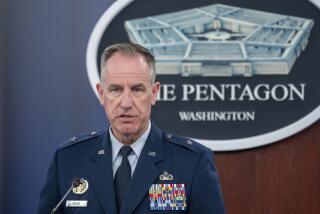Secret Operation Safeguarded Uranium : Kazakhstan: U.S. worked for months to arrange transfer. Clinton calls it a major non-proliferation success.
WASHINGTON — Kazakhstan’s decision to transfer half a ton of weapons-grade uranium to the United States involved months of top-secret negotiations, assembly of a garage-size processing facility in remote Ulba and a clandestine airlift, U.S. officials said Wednesday.
Details of the operation, which was designed to prevent the uranium from falling into the hands of rogue Third World governments, were revealed Wednesday, a day after U.S. officials disclosed that they had succeeded in bringing the material to the United States.
The more than 1,000 pounds of highly enriched fuel, which the officials said was enough to manufacture 20 to 36 nuclear bombs or warheads, was left over from Kazakhstan’s days as a Soviet republic and was poorly stored and vulnerable to smuggling.
Over a nine-month period, U.S. technicians tested and dehydrated the uranium, packaged it in special containers and flew it to the Energy Department’s facility at Oak Ridge, Tenn., for reprocessing into commercial-grade fuel that no longer will be usable for weapons.
President Clinton on Wednesday called the operation a major success for the Administration’s counter-proliferation efforts. “One more threat of nuclear terrorism and proliferation has been removed from the world,” he said. “Today, this is a good day.”
The story, as told by senior U.S. officials at a news conference, began early this year, when Kazakh President Nursultan A. Nazarbayev personally brought the uranium cache to U.S. attention, asking for help in safeguarding and disposing of the unneeded material.
The uranium had been used by a Soviet metallurgical facility that had used it to produce fuel for nuclear warships. Kazakhstan no longer had any need for the material and had no way of keeping it properly stored and secure from possible pilferage.
Over the next several months, U.S. officials entered into detailed negotiations with the Kazakhs, bringing in the Russians to make sure they were aware of the pending arrangement and had no serious objections.
The U.S.-Russian side of the deal was worked out by a bilateral commission headed by Vice President Al Gore and Russian Prime Minister Viktor S. Chernomyrdin. By June, the Russians were fully on board. The United States and Kazakhstan finally could go ahead.
The terms of the arrangement were simple enough: U.S. technicians would extract uranium from the cache and send it to Oak Ridge for reprocessing. The entire process would be overseen by the International Atomic Energy Agency.
At Oak Ridge, technicians began preparing for the venture. Scientists built a garage-size processing facility in Tennessee, tested it and took it apart again for reassembly at the Ulba plant in Kazakhstan. Security drills were conducted every day.
In early October, a team of 31 Americans--from the Pentagon, State Department and Martin-Marietta Corp., the prime contractor at Oak Ridge--traveled to Kazakhstan for a six-week operation designed to bring the uranium to the United States safely.
The job was a complex one. The material was scattered in several different batches and in different forms. It had to be prepared carefully for removal, dried and baked so that it could be packaged in cans.
The process included opening 1,050 Soviet-era containers of highly enriched uranium. The material was repackaged in 456 special U.S.-made containers and loaded on U.S. military planes. The radioactive uranium required special handling so the technicians would not be contaminated.
But the technical side was only part of the job. Because of the threat of pilferage or smuggling, the team had to operate under top-secret security procedures.
The team worked 12 to 14 hours a day, six days a week.
Finally, late Sunday morning, the first section of the uranium deposits was loaded aboard a U.S. Air Force C-5A cargo plane and flown to Dover Air Force Base in Delaware on the first leg of the mission. Two other planes followed, each about 12 hours apart.
At Dover, the containers were placed on trucks and hauled in convoys to Oak Ridge under heavy security. The final shipment arrived early Wednesday morning. Television networks, which became aware of the story Tuesday, were asked to hold it off the air.
For the Administration, the transfer of the former Soviet uranium stockpile marked something of a diplomatic coup--precisely what it had been trying to accomplish. Iran already has tried to buy Kazakhstan’s uranium, and other countries had expressed interest.
U.S. intelligence agencies have pointed to a growing number of Third World countries--from Iran to North Korea--that either have nuclear weapons programs or are trying to buy bombs.
The Clinton Administration has been engaged in a multi-pronged effort to rein in nuclear proliferation, both through traditional diplomatic efforts and by providing U.S. technical and financial aid to keep nuclear materials under closer scrutiny. However, the transfer deal involving Kazakhstan is the first of its kind.
For Kazakhstan, the move meant new recognition around the globe and several hundred million dollars in compensation from the United States. (U.S. officials are refusing to make public the amount for fear of setting a “floor” for other negotiations that may come up.)
In Moscow, news of the uranium transfer brought protests from some conservatives, who argued that former Soviet nuclear stocks should by rights belong to Russia and that the Kremlin should control their disposal more closely.
“All the weaponry in the Soviet Union was made by Russians,” said Valery Davydov, an expert on nuclear non-proliferation at the USA-Canada Institute, a prestigious Russian think tank. “The Kazakhs could never create nukes by themselves--that’s clear.”
Davydov warned that the Kazakhstan deal would “give a very strong card to the opposition in Russia. They will yell that Russia’s national security is on sale, without Russia’s control.”
But the Russian government stuck by the agreement Wednesday, and there was little doubt that the Clinton Administration considered it a red-letter day. Defense Secretary William J. Perry said that the United States did not yet have any other takers for such a transfer of nuclear material. But he left the door open.
Times staff writers Richard Boudreaux and Carey Goldberg contributed to this article from Moscow.
More to Read
Sign up for Essential California
The most important California stories and recommendations in your inbox every morning.
You may occasionally receive promotional content from the Los Angeles Times.










